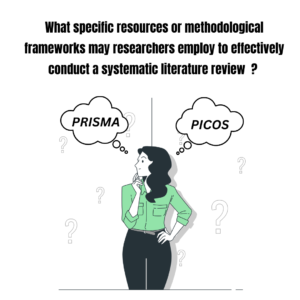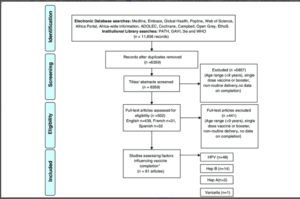A systematic literature review is a valuable tool that researchers can utilize to gather and analyze existing knowledge and evidence related to a specific research topic. It involves a comprehensive and rigorous approach to reviewing published studies, academic papers, and other relevant sources of information. By conducting a systematic literature review, researchers can gain a deeper understanding of the existing body of knowledge, identify research gaps, and inform their own research design and methodology. This blog explores the various ways in which researchers can take advantage of a systematic literature review when conducting their research, highlighting its benefits and significance in the research process.
Before diving into the topic, we need to know the examples of systematic literature review topics to fully know how we can take advantage of it. So, let’s dive into it.
Examples of systematic literature review
Here are a few examples of systematic literature review topics across different disciplines;
- The impact of mindfulness-based interventions on stress reduction: A systematic literature review and meta-analysis.
- Effectiveness of cognitive-behavioral therapy in treating depression: A systematic review and meta-analysis of randomized controlled trials.
- The role of nutrition in preventing cardiovascular diseases: A systematic literature review of observational studies and clinical trials.
- The effects of exercise on cognitive function in older adults: A systematic review and meta-analysis of randomized controlled trials.
- The effectiveness of school-based bullying prevention programs: A systematic review of intervention studies.
- The impact of social media on body image dissatisfaction and disordered eating behaviors: A systematic literature review.
- The role of artificial intelligence in healthcare diagnosis and treatment: A systematic review of current applications and challenges.
- The effectiveness of virtual reality-based interventions in pain management: A systematic literature review and meta-analysis.
- The impact of parental involvement on academic achievement: A systematic review of longitudinal studies.
- The effectiveness of mindfulness-based stress reduction programs in workplace settings: A systematic review of controlled trials. These examples highlight how systematic literature reviews can be conducted across various research domains, including psychology, healthcare, education, technology, and social sciences.
To know the ways in which a researcher can take advantage of a systematic literature review, we need to go to the root of it by covering some in-depth questions on it.
So the first question is:
How does the integration of a systematic literature review into the research process enhance the identification and selection of relevant research gaps and research questions?
The integration of a systematic literature review into the research process can significantly enhance the identification and selection of relevant research gaps and research questions in several ways:
A comprehensive review of existing knowledge: A systematic literature review involves a rigorous and systematic search and analysis of existing research studies within a specific field or topic. By conducting such a review, researchers gain a comprehensive understanding of the current state of knowledge, identifying what has already been explored and established. This enables them to identify gaps in the existing literature and areas where further research is needed.
Identification of research trends and emerging areas: A systematic literature review allows researchers to identify research trends, emerging concepts, and innovative approaches within their field. By analyzing a wide range of studies, researchers can observe patterns, recurring themes, or novel ideas that can inform the development of relevant research questions. This process helps them identify gaps in knowledge that need to be addressed or areas where new research directions can be pursued.

The second question is
What specific methodological frameworks or tools can researchers employ to effectively conduct a systematic literature review and extract valuable insights for their research ?
Researchers can employ several methodological frameworks and tools to effectively conduct a systematic literature review and extract valuable insights for their research. Here are some specific frameworks and tools commonly used:
PRISMA (Preferred Reporting Items for Systematic Reviews and Meta-Analyses): PRISMA is a widely recognized framework for conducting systematic literature reviews. It provides a structured approach for transparently reporting the review process, including study selection, data extraction, and synthesis. Adhering to the PRISMA guidelines ensures the rigor and transparency of the review.
PICOS (Population, Intervention, Comparison, Outcome, Study Design): PICOS is a framework used to define the key components of a research question for a systematic literature review. It helps researchers specify the relevant population, intervention or exposure, comparison group, outcome measures, and study design characteristics to guide the search and selection of studies.
Number three in this list is,
How can researchers leverage the findings and conclusions from a systematic literature review to inform the development of a comprehensive theoretical framework or conceptual model for their research study ?
Researchers can leverage the findings and conclusions from a systematic literature review to inform the development of a comprehensive theoretical framework or conceptual model for their research study in the following ways:
Identify gaps and limitations: Through a systematic literature review, researchers gain insights into existing theories, models, and frameworks in their field. They can identify gaps, limitations, or inconsistencies in the current body of knowledge. This knowledge allows researchers to position their own study within the context of existing theories and identify areas where their research can contribute to filling these gaps.
Synthesize key concepts and variables: A systematic literature review helps researchers identify the key concepts and variables that are commonly used or emphasized in previous studies. By analyzing the findings from multiple studies, researchers can extract and synthesize these concepts to form a foundation for their own theoretical framework or conceptual model. This synthesis provides a solid basis for developing hypotheses and research questions.
The fourth question is
What strategies can researchers employ to overcome potential biases or limitations associated with the inclusion and exclusion criteria used during the systematic literature review process ?
Researchers can employ several strategies to overcome potential biases or limitations associated with the inclusion and exclusion criteria used during the systematic literature review process. Here are some key strategies:
Clearly define inclusion and exclusion criteria: It is crucial to establish clear and explicit criteria for including or excluding studies from the review. These criteria should be well-documented and based on the research objectives and research questions. Clearly defining the criteria helps minimize subjectivity and potential bias in the selection process.
Use multiple reviewers and inter-rater reliability checks: Involving multiple reviewers in the study selection process can help mitigate individual biases. Each reviewer independently evaluates the relevance of studies against the inclusion and exclusion criteria. To ensure consistency and minimize discrepancies, reviewers can conduct inter-rater reliability checks, where a subset of studies is assessed by multiple reviewers, and agreement rates are calculated. Discrepancies can be resolved through discussion and consensus.
The last question is
How does the utilization of advanced data mining and text analysis techniques within a systematic literature review enhance the identification of emerging research trends, theoretical frameworks, or practical applications that can shape the direction of future research?
The utilization of advanced data mining and text analysis techniques within a systematic literature review can significantly enhance the identification of emerging research trends, theoretical frameworks, and practical applications, ultimately shaping the direction of future research. Here’s how:
Efficient identification and extraction of relevant information: Advanced data mining and text analysis techniques can automate the process of identifying and extracting relevant information from a large volume of scholarly articles. These techniques can efficiently analyze titles, abstracts, keywords, and full-text documents to identify key concepts, relationships, and patterns that may not be immediately apparent through manual review. This enables researchers to quickly and comprehensively assess the landscape of existing literature.
Identification of emerging research trends: By applying data mining and text analysis techniques, researchers can detect emerging research trends that may not be easily identifiable through traditional methods. These techniques can identify keywords, topic clusters, co-occurrence patterns, or citation networks that highlight areas of active research or emerging topics within a field. Identifying these trends allows researchers to focus on novel and timely areas for further investigation.
In conclusion, researchers can take full advantage of a systematic literature review by using it as a foundation for their own research, enhancing their critical thinking skills, informing evidence-based decision-making, and fostering collaboration and knowledge exchange. By harnessing the power of existing knowledge, researchers can make meaningful contributions to their respective fields and drive positive change.
If you want us to cover more questions on this topic, then you can comment below.
Also, don’t forget to like and share if you have gained some new insight from this blog.
Thank you for reading this blog, it made my day .

